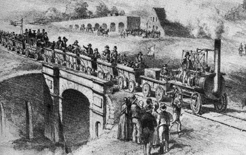Railways meant the end for canals and coaches. Railways were to transform Britain in the nineteenth century. Wagons pulled along on tracks had existed for some while, but these wagons had been pulled by horses. Advances in railways took place throughout the nineteenth century but there are a number of key dates in the history of railways :
1804 : Richard Trevithick built a steam locomotive for his iron works at Penydarren in Wales. It was essentially built for a bet but it did manage to pull ten tonnes of iron. However, like most first models, it was highly unreliable. What he did, encouraged others to improve on his design.
1811 : John Blenkinsop invented a steam engine which had cogs on one of its wheels. These gripped an extra rail laid down on the normal rail line and gave his engine more grip.
1813 : The “Puffing Billy” was built by William Hedley to pull coal wagons at the Wylam Colliery in Northumberland. It was so reliable that it was used for fifty years.
A man called George Stephenson lived in Wylam. His father looked after the pumping engine at the colliery. By the time George was fifteen, he was working on the same engine as his father. George Stephenson was fascinated by steam engines and in 1821 he was made engineer for the colliery. The owners of the colliery decided to build a rail line from Stockton to Darlington so that they could move their coal to a large market with more ease. Stephenson was given to job of building this line.
1825 : the Stockton to Darlington rail line was opened. Two locomotives were used (the “Experiment” and “No 1”) and they could pull 21 coal wagons 25 miles at 8 miles per hour. This was unheard of at the time and soon the line was in profit. Passengers were soon carried but steam trains did not operate on the line for passengers until 1833. In many senses, 1825 is seen as the start of the Age of the Railways.

The opening of the Stockton to Darlington railway
1826 : George Stephenson was given a much bigger task – to build a railway between Manchester and Liverpool. However, the company financing the scheme was not convinced that steam trains would worked properly on this rail line. They organised a competition to find out what train and which type of train would be best for their line. The competition was to be held at Rainhill near Liverpool.
1829 : the Rainhill Trials took place. The winning train was the legendary “Rocket” built by George Stephenson. He won £500. The “Rocket” travelled at 46 kph – about 30 mph.
1830 : the Liverpool to Manchester railway opened
The success of Stephenson’s train caught the public’s imagination and so-called “Railway Mania” took place. Railways were seen as a way of earning a fortune. Between 1825 and 1835, Parliament agreed to the building of 54 new rail lines. From 1836 to 1837, 39 new lines were agreed to. By 1900, Britain had 22,000 miles of rail track.
Railways greatly helped industry. But not everybody approved of them. The Duke of Wellington – famed for leading Britain to victory at the Battle of Waterloo – feared that trains might encourage the poor and undesirables in society to come to London and that any trains coming from places such as Bath and Bristol had to pass near to Eton School and that the pupils there might be disturbed !! Some farmers believed that trains could cause cows to produce stale milk but trains did allow farmers to get their products to market quicker and this was very important to farmers producing perishable goods.
1838 : Robert Stephenson, the son of George, completed the London to Birmingham rail line.
1841 : Isambard Kingdom Brunel completed his London to Bristol line – the Great Western Railway. This was such a stunning achievement that people used the rail line’s initials (GWR) to call it “God’s Wonderful Railway“)
How did railways change society ?
rail travel, despite the investment made into making rail lines, was 50% cheaper than coach travel.
it was also a lot quicker and opened up Britain in a way that coach travel could not do. Seaside fishing villages suddenly became fashionable and popular as day trips to the coast became common.
even the poor could afford rail travel as three different classes of travel existed – third class meant travelling in open topped carriages but the price was such that the less well off in society could use trains.
towns and cities had cheaper food as farmers could get their perishable products to market quicker and cheaper. Inland towns could now get fresh fish !!
Many thousands of miles of rail were built and they transformed Britain. The heavy work of building was done by men who became known as navvies.